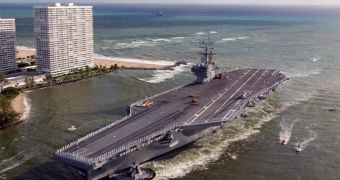The US Office of Naval Affairs has offered a grant to researchers at Rensselaer Polytechnic Institute who are collaborating with four other universities, to come up with solutions to a hot problem in the military naval force.
Modern war and tactical naval operations require sailors and other military personnel to operate more advanced electronics in hotter climates. Modern military ships, offices, and planes have thousands of computers, lights, and other electronics whirring and working at once, generating extremely high temperatures that require advanced cooling systems.
The largest US naval ship will be the USS George H. W. Bush supercarrier, 1 092 ft (333 m) long, weighing 104 000 tons fully loaded and having a crew complement of around 6 000 men, and state of the art electronics.
Due to the increasing power levels of today's electronics, and the need for these systems to operate at super-fast speeds in extreme environments, researchers need to find new cooling methods to lengthen the life of electronics and increase system performance, according to Michael Jensen, professor of mechanical, aerospace, and nuclear engineering and project manager for Rensselaer's part of the project.
The $7.5 million grant is aiming for the development of thermal management techniques that reduce device temperatures below 50 degrees Celsius. To do this, each of the universities will use their research strengths, handling different research thrusts that will later be integrated to help develop the next generation of ultra-efficient electronic systems.
"We are looking to make fundamental advancements in thermal regulation of electronic systems, from pinky-nail-sized chips to an entire computer server farm at a high-tech company or a 500-foot Navy ship," Jensen said. "We are reaching the limit of what we can do with air cooling of new computer chips. We are now looking at liquid cooling as an alternative method to cool electronic circuitry."
The major problem will be to uncover the mechanisms that govern fluid flow and heat transfer in novel electronic cooling systems. As part of that process they will examine the flow and cooling levels of different liquids through micro-devices. This will help them develop modifications to material surface chemistry and structure, understand ideal microchannel configurations and examine the use of nanoparticle suspensions within liquid coolants to improve overall cooling.
Boiling heat transfer and cooling effects will have to be developed and proposed to the army, who will thoroughly test the new applications before deciding which one will be suitable to implement on war vessels.

 14 DAY TRIAL //
14 DAY TRIAL //